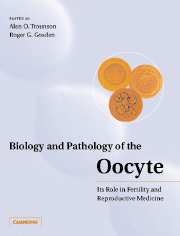Book contents
- Frontmatter
- Contents
- List of contributors
- Preface
- Part I Historical perspective
- Part II Life cycle
- Part III Developmental biology
- Part IV Pathology
- Part V Technology and clinical medicine
- 17 Growth and development of the mammalian oocyte-granulosa cell complex in culture
- 18 Human oocyte maturation in vitro
- 19 Follicular factors affecting oocyte maturation and developmental competence
- 20 Low temperature storage of follicular and ovulated oocytes
- 21 Fecundity of transplanted ovaries
- Index
20 - Low temperature storage of follicular and ovulated oocytes
from Part V - Technology and clinical medicine
Published online by Cambridge University Press: 05 August 2016
- Frontmatter
- Contents
- List of contributors
- Preface
- Part I Historical perspective
- Part II Life cycle
- Part III Developmental biology
- Part IV Pathology
- Part V Technology and clinical medicine
- 17 Growth and development of the mammalian oocyte-granulosa cell complex in culture
- 18 Human oocyte maturation in vitro
- 19 Follicular factors affecting oocyte maturation and developmental competence
- 20 Low temperature storage of follicular and ovulated oocytes
- 21 Fecundity of transplanted ovaries
- Index
Summary
Introduction
For several decades, cryopreservation has been a cornerstone of reproductive medicine and animal production technology. Following its introduction for semen banking, it has become applied for embryos, oocytes and even the gonads. The advantages, proven and prospective, are: (1) the augmentation of clinical success with in vitro fertilization (IVF) by conserving spare embryos; (2) facilitation of egg donor programmes; and (3) preservation of immature germ cells in children and young adults at risk of premature sterilization. While embryos and mature oocytes are normally collected after controlled ovarian stimulation with gonadotropins, no prior preparation is necessary for collecting primordial follicles in ovarian tissue. Since an efficient technology does not yet exist for growing these follicles to Graafian stages in vitro, thawed tissue must be grafted, either heterotopically to generate oocytes for IVF or orthotopically to restore natural fertility. However, only a minority of the follicle reserve survives and, therefore, grafts usually function for only a short time. Progress is now being made to preserve intact organs for vascular transplantation, which could restore a normal span of reproductive life and avoid early menopause. Cryotechnology has had a generally good safety record, although the incidence of aneuploidy may increase after cooling mature oocytes, and former cancer patients should not receive autografts if there is any risk of transmitting residual disease. Despite these problems and slow progress towards optimal protocols, low temperature banking of ovarian tissue and oocytes is gradually becoming another reproductive option for patients.
When and how was cryopreservation discovered?
In the late 1940s, a research group led by A. S. Parkes in London achieved almost by accident a breakthrough in low temperature preservation (Polge et al., 1949). After many unsuccessful attempts to cryopreserve fowl sperm using sugar solutions, they obtained an almost perfect result. But the experiment could not be repeated. It was soon discovered that bottle labels had become detached in the refrigerator and switched, and they had unknowingly been using glycerol. Their subsequent experiments, principally by Audrey Smith and James Lockwood, laid down principles which have changed little over 50 years. Considering the resources available at the time, their achievements were remarkable.
- Type
- Chapter
- Information
- Biology and Pathology of the OocyteIts Role in Fertility and Reproductive Medicine, pp. 316 - 326Publisher: Cambridge University PressPrint publication year: 2003



